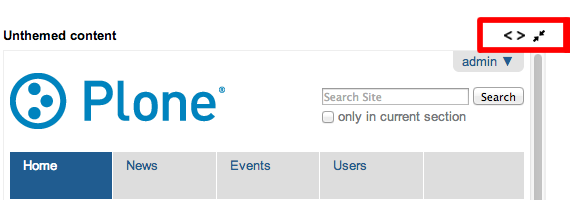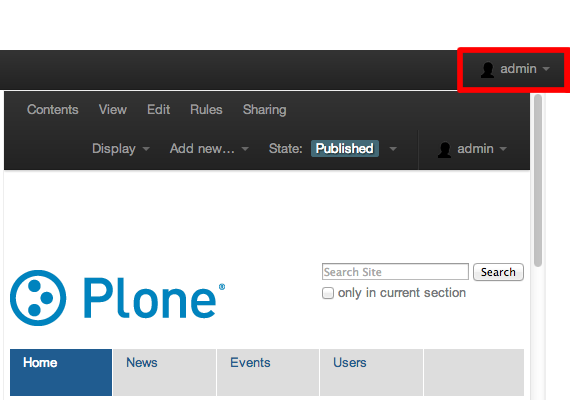Workshop: Theming with Diazo
On Wednesday the 12th of December, Goldmund, Wyldebeast & Wunderliebe organised a Diazo workshop. Douwe van der Meij and Kim Chee Leong introduced us to the wonderful world of theming Plone the easy way (my words, not theirs). Since this workshop took a full day, this is not a complete summary but a more an extended version of the notes I took during the day.
Introduction
Diazo is for (re)theming websites. Not just Plone sites, it works on any technology. Diazo combines the HTML of the website—the content—with the HTML of the theme provider—the theme—to deliver a themed website.
With Diazo there is a natural separation between the HTML delivered by the designer or frontend developer and the logic (calculations, data, etc) which is usually handled by the backend developer. It adds an additional level of abstraction to the stack. To put it differently: Diazo offers an interface between the developers and the designers, while keeping a clear separation of responsibility. Because the developer does not have to transform the HTML from the designer into (TAL) templates, this also removes a step from the process where normally errors can creep in.
Diazo can be put in front of your existing website; the technology used for the website does not matter. The existing website is still there. You can have the multiple designs for a single website at the same time. You can even use Diazo to only apply the theme when you are on a sub site.
Diazo uses XSLT but, theoretically, you do not have to write XSLT yourself. Which is good because XSLT is hard to read. If you do write XSLT, don’t forget to place comments so a month from now you still understand what you wrote today.
When you change the Plone output so it delivers what the Diazo theme expects, you have to write less complex rules and require as little XSLT as necessary. You can also create a theme that takes the output of Plone into account so less transformation is required.
Speaking of those rules: for an overview of available rules and the
order in which they are processed (for instance <drop /> is
executed before <replace />), see the
Diazo documentation.
Tooling
The package
plone.app.theming
provides an interface to modify themes. It allows you to edit your
rules.xml file and the rest of the them from within Plone. By using
the inspectors you can also select elements in your theme and content
(Plone site) and have the editor create a rule for you. (From what
I’ve seen during the workshop you likely want to tweak the rule
somewhat but it’s a starting point.)
It is possible to set hostnames that use the unthemed version of
the site in the advanced settings of the theming control panel. By
default 127.0.0.1 is listed there.
Creating a theme
A Diazo theme expects a specific layout. Obviously you’ll need to have
your theme: an HTML file (index.html for example) and accompanying
assets (CSS, JavaScript, images). Besides those files, you also need
to have the files manifest.cfg, rules.xml and an image with a
preview of the theme, preview.png.
An example of a manifest.cfg file:
[theme]
title = Demo Theme
description = My first Diazo theme
preview = preview.png
For details on the content of the manifest.cfg file, check out the
manifest file section
plone.app.theming documentation.
A very basic rules.xml file to get started:
<?xml version="1.0" encoding="UTF-8"?>
<rules
xmlns="http://namespaces.plone.org/diazo"
xmlns:css="http://namespaces.plone.org/diazo/css"
xmlns:xsl="http://www.w3.org/1999/XSL/Transform">
<theme href="index.html" />
</rules>
The <theme href="..." /> line makes sure that the index.html file
from the theme is used. Otherwise you would still see the Plone theme.
Note that you can split up the rules into several files. For instance:
<?xml version="1.0" encoding="UTF-8"?>
<rules
xmlns="http://namespaces.plone.org/diazo"
xmlns:css="http://namespaces.plone.org/diazo/css"
xmlns:xsl="http://www.w3.org/1999/XSL/Transform"
xmlns:xi="http://www.w3.org/2001/XInclude">
<theme href="index.html" />
<xi:include ref="rules_normal.xml" />
<rules if-content="/html/head/title[.='foo']">
<xi:include ref="rules_foo.xml" />
</rules>
</rules>
To make the Plone site editable in the themed site, you need to add the following to your rules:
<after
css:theme-children="html head"
css:content="html head script"
/>
<after
css:theme-children="html head"
css:content="html head base"
/>
Note that this only includes the JavaScript and the <base /> element
from Plone. To actually show the edit bar, you’ll need to add some
additional rules and also include some CSS in your theme to style it
properly.
You could also try to use plone.app.toolbar. But note that currently (plone.app.toolbar 1.1 and plone.app.theming 1.1b1) there is a small user interface problem: the toolbar is on top of the controls when you expanded the HTML mockup or unthemed content inspector.

Inspecting the unthemed content without the Plone Toolbar
If you do not have the Plone Toolbar installed, you can toggle the source view and full screen mode of the inspector. But when the Plone Toolbar is installed, it overlaps with these controls.

Inspecting the unthemed content with the Plone Toolbar
As long as the page is long enough that you can scroll down, you can do just that to reveal the controls again. (Since the controls scroll with the page while the position of the toolbar is fixed, they show up when you scroll on the page.)
Summary
Diazo is a wrapper around XSLT. It provides a seamless integration to (re)theme your website. It provides a higher level of abstraction, but you can also use XSLT as a fallback.
Although you can use Diazo without Plone, there currently is only tooling within Plone.
My conclusion
This was my first introduction to Diazo. My initial reaction is that I like the separation of concerns and responsibility between front- and backend. I can also imagine that it is easier to work with other parties that build the theme (HTML and CSS) and do not require in-depth Plone knowledge. I cannot yet judge on potential gains in time when comparing the development of a Plone theme with building a Diazo theme.
I am glad that you can edit the rules from within Plone and have the inspectors to help you selecting the elements. At the same time I can imagine that someone with more knowledge about Diazo, XSL and the actual output of Plone (which isn’t my expertise) rather just works on file system with their editor.
There are also a few things that we at Edition1 need to investigate and/or solve before we can even think about using Diazo for our customers. For instance, we use collective.editskinswitcher combined with collective.lineage. Our customers have a separate edit skin (with a preview of the content as the visitors of the site will see it) and can select a theme per child site. We’ll have to see how we can replicate something similar with Diazo, perhaps by using lineage.themeselection. That is: assuming we want to keep this setup—the Plone Toolbar also looks really nice!
Either way, I learnt a lot. So thanks Douwe, Kim Chee and Goldmund, Wyldebeast & Wunderliebe for organising the workshop!